The 2019 NHL Entry Draft is less than two weeks away, taking place on June 21-22 in Vancouver. After not possessing a first-round pick in 2018, the Nashville Predators and general manager David Poile enter this year’s draft with theirs still intact. The Predators remain one of the league’s better teams, and with a few tweaks, they should enter the 2019-20 season as a Stanley Cup contender. However, their farm system is in shambles thanks to prospect graduation, trades, and poor drafts.
Related: THW’s Free Draft Guide
That’s why the 2019 Draft needs to be about rebuilding that farm system with prospects who can be future difference-makers. That replenishing of the farm system starts with their first-round selection, which is currently the 24th-overall pick.
Predators’ Needs in 2019 Draft
I recently wrote an article that discussed the state of the Predators’ farm system. In it, I covered what I think Poile’s approach should be at the draft. To reiterate what I wrote, the Predators need wingers and defensemen. That’s why with their first-round pick, my approach would be drafting a winger who can develop into a future top-six NHLer or a defenseman they feel can eventually be a top-four puck-moving blueliner. Replacing Dante Fabbro and simply adding forward depth to their farm system need to be of the upmost importance at the draft. With that being said, here are eight options for the Predators with their first-round pick.
Lassi Thomson, D, Kelowna Rockets
Rankings:
- 36th by THW’s Ryan Pike
- 36th by The Hockey News
- 35th by Bob McKenzie
Defenseman Lassi Thomson is an intriguing prospect in the 2019 Draft. After playing in the Finnish junior leagues, he joined the WHL’s Kelowna Rockets for the 2018-19 season, his first in North America. He played quite well, especially offensively, with 17 goals and 41 points in 63 games. Described as an offensive defenseman, his hard, accurate shot makes him a threat on the power play. However, he’s also unafraid to have the puck on his stick, leading rushes, and eluding opponents, which makes him a strong five-on-five player as well. His skating excels in all areas and situations and helps him move the puck out of trouble.
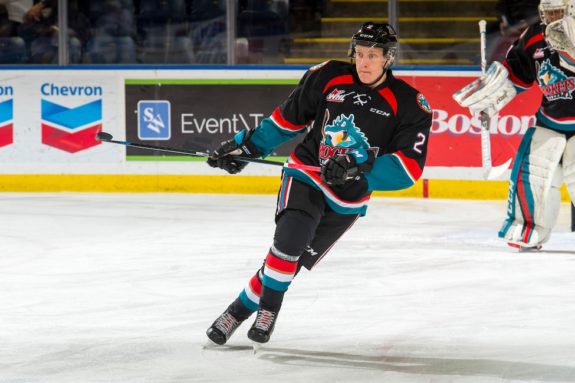
He needs to improve defensively and be more consistent with the puck, as he’s prone to turnovers and being overly aggressive in the offensive zone. He also struggled a bit with the physicality and checking of the WHL, often taking too many unnecessary hits after distributing the puck. If he can develop in these areas, he projects as a top-four right-shot blueliner, and at 6-feet and 190 pounds, he’s the epitome of the modern day NHL defenseman. He already has a contract with Ilves of Finland’s Liiga that extends for at least two seasons.
It will be interesting to see how returning to the larger ice of Finland impacts his development. Given that most rankings have him in the 30s to 40s, Thomson is a player the Predators could move down for, or simply take earlier than expected if they like him enough. It’s easy to envision him beneath Fabbro on the right side of the Predators’ blue line depth chart in a few years.
Ville Heinola, D, Lukko
Rankings:
- 27th by THW’s Ryan Pike
- 20th by The Hockey News
- 24th by Bob McKenzie
Related: Ville Heinola’s Draft Profile
Like Thomson, Ville Heinola is a Finnish defenseman. However, he played this season in the Liiga with Luuko. In Finland’s top league, he had two goals and 14 points in 34 games as a rookie. That’s not a great total until you consider that current Dallas Stars defenseman Miro Heiskanen had five goals and 10 points in 30 games his rookie season. I bring up Heiskanen intentionally, because the similarities between he and Heinola are extensive. Like Heiskanen, Heinola is an incredible skater even if he isn’t the fastest. His edgework jumps off the screen, and what I found most impressive is that he accelerates on the crossover, something only great skaters do.
Heinola is best known for his offensive abilities, especially when it comes to making the right reads. His vision and hockey sense stand out, and the’re displayed in him making no-look, cross-ice passes that nearly always end up on a teammate’s stick. Yet he still possesses an accurate shot that demands attention and forces opponents to cover him. Defensively, he needs some work, but he’s a step ahead of Thomson. Heinola uses his skating to backcheck, yet doesn’t overly rely on it, instead depending on positioning.
“You don’t need to overthink the comparable when talking about Heinola. Scouts in Europe are pretty much unanimous in thinking that he resembles a Finnish rookie with the Dallas Stars. ‘He’s a poor man’s Miro Heiskanen.'”
From The Hockey News’ Draft Preview
Like a majority of European defensemen, he uses his stick as opposed to his body to check opponents, but is unafraid to engage in board battles despite his 5-foot-11 frame. He needs to pack on some muscle, get more physical, and be more consistent defensively, but the sky is the limit for him. He projects as a top-four blueliner with a clear path to top-pair minutes. He’s currently projected to go in the early 20s, so there’s a chance he’s off the board when the Predators pick, but if he’s still available, they need to snatch him up. As a left-shot blueliner, he would potentially be Fabbro’s long-term defense partner.
Bobby Brink, RW, Sioux City Musketeers
Rankings:
- 24th by THW’s Ryan Pike
- 27th by The Hockey News
- 33rd by TSN’s Bob McKenzie
All that Bobby Brink has done this season is rocket up the draft rankings. He finished his sophomore season in the USHL with 35 goals and 68 points in 43 games. By comparison, current Predators prospect Eeli Tolvanen had 30 goals and 54 points in 52 games in his second USHL season. Brink finished the season by winning the league’s forward of the week award three straight times. He’s one of the best goal-scorers in the draft thanks to an elite shot. For Team USA at the 2019 U18 World Championship, he played the half-wall on the top power-play unit and excelled at creating space for himself to unleash his shot or display his underrated vision to find the open man.
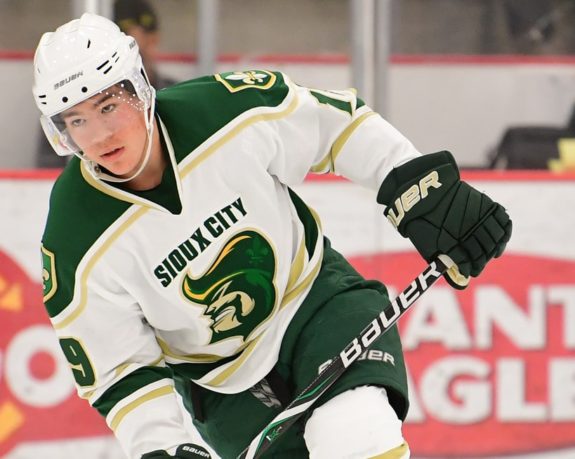
He needs to improve his skating, perhaps his only flaw, but it remains good enough to succeed at the next level. Despite being known for his offensive abilities, he is devoted to playing defense, whether it’s on the backcheck or supporting defensemen down low. He’s also skilled at clogging passing lanes to generate turnovers. Despite being slightly undersized at 5-foot-10 and 163 pounds, Brink’s unafraid to go to the dirty areas or win a board battle. His willingness and determination are unmatched.
He’s the future top line forward the Predators need. Committed to play at the University of Denver, he’s a couple years away from the NHL, which is good because he needs to bulk up and develop his skating. Projected to go in the mid-to-late 20s, there’s a good chance he’s available when the Predators pick.
Philip Tomasino, C, Niagara IceDogs
Rankings:
- 23rd by THW’s Ryan Pike
- 41st by The Hockey News
- 34th by TSN’s Bob McKenzie
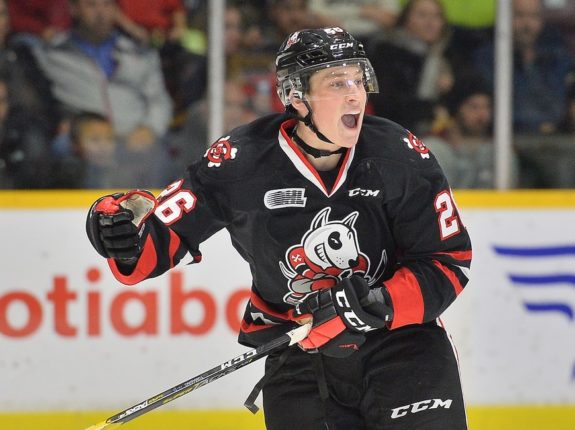
Philip Tomasino is one of the youngest players in the draft and won’t turn 18 until the end of July. In his second season with the Niagara IceDogs of the OHL, he posted 34 goals and 72 points in 67 games, tripling his point total from last season. Playing on a great IceDogs team that only got better with mid-season trades, he found himself playing lower on the depth charts than he would have on most other teams. He still managed to have an excellent season and is already a strong two-way center.
Related: Philip Tomasino’s Draft Preview
He is a great skater who enjoys leading the rush and is perfectly comfortable with the puck on his stick. Watching footage of him shows his ability to battle through tight checking and still emerge with possession of the puck. In several instances, opponents had to rely on hooking or holding to attempt to impede his progress, and typically to no avail. While he does everything well, he doesn’t do anything at an elite level, which leads to him projecting as a second-line center, something the Predators could use.
Considering his age, he’s several years away from the NHL, which is fine, as he needs to add some muscle to his frame. With many draft experts ranking him in the 30s, or even the 40s, the Predators could look to trade down to the second round to draft him. However, I like his skillset enough for them to even take him at 24.
Samuel Poulin, LW, Sherbrooke Phoenix
Rankings:
- 19th by THW’s Ryan Pike
- 23rd by The Hockey News
- 28th by TSN’s Bob McKenzie
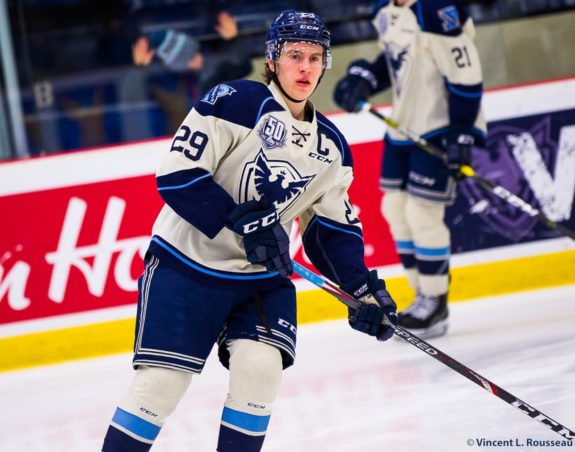
Samuel Poulin embodies what the Predators need as well as any other prospect in the draft. In 67 games with the QMJHL’s Sherbrooke Phoenix, he totaled 29 goals and 76 points in his second season. He added another 14 points in 10 playoff games to pace the team. Poulin is a dynamic goal scorer thanks to his unreal release and shoot-first mentality.
He knows where to find the soft spots in coverage and wait for a pass to arrive. And when the puck does arrive, his shot is accurate enough to beat goaltenders from anywhere when he’s on his forehand. However, he’s more than just a sniper. He is a solid enough puck-handler to go one-on-one versus defensemen, often making them look foolish. He also has excellent vision and his playmaking and passing abilities are underrated.
Related: Samuel Poulin’s Draft Profile
He uses his 6-foot-2, 206-pound frame to his advantage, hounding defenders on the forecheck and is physical in board battles. He’s also unafraid to go to the gritty areas to score. He wore a letter in his second season, possessing the leadership traits that front offices love. If there’s a negative to his game, it’s his stride and footspeed. While he’s a strong skater and can get to top speed, he lacks acceleration and struggles to pull away from defenders. He needs to work on his first three strides in order to make it in the NHL.
If he does develop that aspect, and there’s no reason to think he won’t, he’s a future top-six winger. The Predators need such a player, as they lack that trusted goal scorer in either the NHL or in the farm system. Considering he’s ranked between the late teens to late 20s, he could still be available when the Predators pick, but there’s no guarantee.
Connor McMichael, C, London Knights
Rankings:
- 22nd by THW’s Ryan Pike
- 24th by The Hockey News
- 26th by TSN’s Bob McKenzie
Related: Connor McMichael’s Draft Profile
When you watch Connor McMichael’s footage, he doesn’t possess that dynamite skill that catches you off guard. However, that’s okay, because what he does show is an ability to do everything well, even if none of it’s elite, right now. The key there is right now. McMichael plays for the OHL’s London Knights, the hockey factory owned and operated by Mark and Dale Hunter. It’s the same program that developed Matthew Tkachuk, Mitch Marner, John Tavares, and Patrick Kane, among many others. So if there’s something you don’t like in McMichael’s game, just wait, because more likely than not it’ll be fixed before he turns pro.
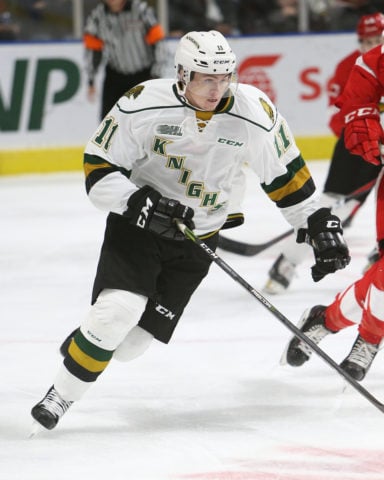
McMichael is a plus player in every facet of the game and in all three zones. Defensively, he provides great puck support and is a quality backchecker. Offensively, he possesses a great shot and the puck leaps off his blade. His speed catches defenders off-guard and he’s a talented puck-handler who goes to the net and follows up on rebounds. He had a productive 2018-19 with the Knights, posting 36 goals and 72 points in 67 games. Those totals were enough to lead the team in scoring despite playing down the lineup thanks to a stacked roster that included Liam Foudy and Alex Formenton up front. It’s likely McMichael plays a bigger role for the Knights next season, which can only mean good things for his production.
“‘He’s not a dynamic player, but he’s quietly efficient. He’s quick, smart and skilled. He finds holes and makes himself available for chances.'”
From The Hockey News’ Draft Preview
He does need to work on being a better protector of the puck, but that’s something that will be worked on next season. What I like about him is that he’s a low-risk/high-reward prospect. At worst, he debuts in the NHL in a bottom-six checking role while providing some offense and never grows out of it.
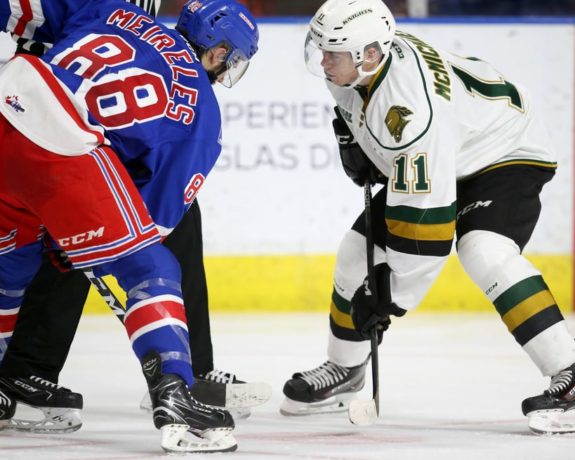
However, if all breaks well, he develops into more of a scorer and is a fixture in a team’s top six, all while playing consistent defense. Likely to go somewhere in the late 20s, the Predators would be lucky to draft him, although selecting someone with higher upside offensively may be a better allocation of resources.
Jakob Pelletier, C, Moncton Wildcats
Rankings:
- 26th by THW’s Ryan Pike
- 25th by The Hockey News
- 31st by TSN’s Bob McKenzie
Related: Jakob Pelletier’s Draft Profile
When I see prospects put up big numbers in the QMJHL, sometimes it gives me pause. Typically, defenses and goaltenders in that league aren’t of the same quality as they are in other junior leagues. So when I saw that Jakob Pelletier scored 39 goals and 89 points in 65 games this season for the Moncton Wildcats, I was skeptical. That was until I watched his tape and read scouting reports. For starters, this isn’t his first time posting lofty totals. In fact, he’s been better than a point-per-game player each of the past four seasons, and that included his first season in the ‘Q.’ So this level of production isn’t new for him.
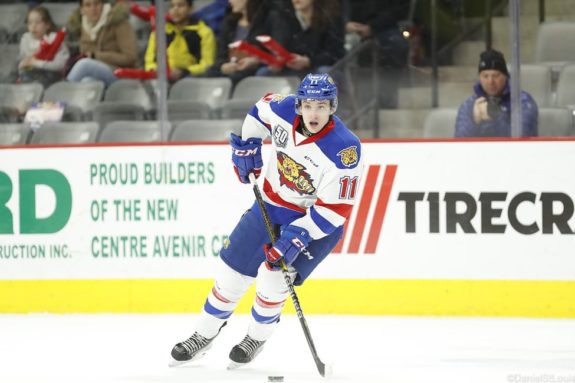
Pelletier can score in a variety of ways, but generally relies on a deceptive shot that is difficult for goaltenders to track. This is due to his ability to subtly alter his shooting angle just before release. In general, he’s good at pretty much everything. He’s a strong possessor of the puck and plays a bigger game than his 5-foot-9 frame would suggest. He’s basically the embodiment of the modern-day NHL. What’s great about him is that his offense doesn’t come at the expense of playing solid defense. He also excels on the penalty kill, often hemming power play units in their own end thanks to his ability to possess the puck.
“‘Goalies seem to have a hard time reading his shot. He gets it off really quickly and on awkward angles and in stride.'”
From The Hockey News’ Draft Preview
If he has any weaknesses, it’s that he’ll absolutely have to get stronger to survive the NHL. He’s already suffered significant injuries, so there are questions regarding his durability. He could also stand to be more selfish with the puck, choosing to shoot a bit more. All-in-all, Pelletier has the opportunity to develop into an excellent top-six forward who can play all three positions. If the Predators get him, and they could as he’s projected to go in the mid-to-late 20s, I could see him being a player similar to Viktor Arvidsson, just with more raw talent. The only question I have is how does Pelletier’s game translate to playing against bigger, better defensemen and more technically-sound netminders?
Nils Höglander, LW, Rögle BK
Rankings:
- 25th by THW’s Ryan Pike
- 28th by The Hockey News
- 29th by TSN’s Bob McKenzie
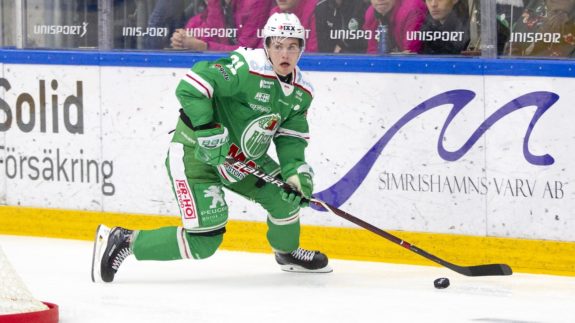
If a Predators fan watches Nils Höglander, one thing will be quickly revealed: he is eerily similar to Arvidsson. Both listed at 5-foot-9, they’re undersized, Swedish wingers who are unafraid to go to the front of the net.
Related: Nils Höglander’s Draft Profile
Höglander’s seven goals and 14 points in 50 games this season don’t stand out. However, he played in Sweden’s SHL, one of the world’s best professional leagues. That means he played against men, so the level of competition is higher than what many draft-eligible players face. He began the season playing around seven minutes per game, but quickly earned the coaches’ trust and averaged 14 minutes late in the season. He also got stronger and gained more confidence as the season progressed to the point where he made the opposition look foolish at times.
What stands out most about his game are his hands, which are silky smooth and allow him to be a near-elite puck-handler. There were many times this season where it appeared as though he was taken out of the play by an opponent’s check, only for Höglander to deke out of the check and generate a scoring chance. His hands, when combined with great eye-hand coordination, help him get tips and deflections on pucks in front of the net, again similar to Arvidsson. Höglander’s ceiling may only be a second-line winger, but he’ll be a great one if he gets there.
Predators’ Best Targets
As I mentioned in the intro, the Predators need scoring. They need it in the NHL and in the farm system. In their franchise’s history they’ve never had a goal-scorer they can rely on to net a timely goal. That’s why I think Poulin and Brink need to be at the top of their draft board. If they don’t land either player, drafting the ‘best available’ player regardless of position is the correct approach. The Predators need to replenish their farm system with skaters, so drafting a forward or defenseman with upside is a good idea.
*All stats came from Elite Prospects